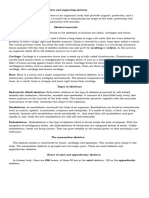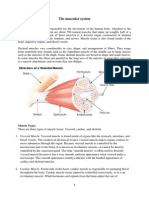Locomotion and Movement Class 11 Notes CBSE Biology Chapter 20 (PDF)
Locomotion and Movement Class 11 Notes CBSE Biology Chapter 20 (PDF)
Uploaded by
ASHISH MALAVCopyright:
Available Formats
Locomotion and Movement Class 11 Notes CBSE Biology Chapter 20 (PDF)
Locomotion and Movement Class 11 Notes CBSE Biology Chapter 20 (PDF)
Uploaded by
ASHISH MALAVOriginal Title
Copyright
Available Formats
Share this document
Did you find this document useful?
Is this content inappropriate?
Copyright:
Available Formats
Locomotion and Movement Class 11 Notes CBSE Biology Chapter 20 (PDF)
Locomotion and Movement Class 11 Notes CBSE Biology Chapter 20 (PDF)
Uploaded by
ASHISH MALAVCopyright:
Available Formats
Revision Notes
Class 11 Biology
Chapter 20 – Locomotion and Movement
Locomotion and Movement
Movement is defined as the movement of living organisms from one place to
another; if the movement causes a change in location or position, it is called
locomotion; such as walking, climbing, running, etc.
Kinds of Movement
There are three kinds of movement which are ciliary, amoeboid, and muscular.
Ciliary Movement
This type of movement occurs in those organs which are covered with ciliated
epithelium. It helps to capture dust particles that are inhaled during breathing and
also helps to move the egg from the fallopian tube into the uterus.
Amoeboid Movement
This type of movement can be seen in some immune cells, such as macrophages and
white blood cells. It can also be seen in amoeba moving through pseudopods.
Fig. 2. Amoeboid movement in Amoeba
Class XI Biology www.vedantu.com 1
Muscular Movement
Muscle movement is seen in the tongue, chin, limbs, etc. The muscles, bones, and
nervous system are all involved in locomotion.
Muscle
Muscle or muscle tissue is essentially mesoderm. It is an organization of cells that is
involved in body movement. Skeletal muscle, smooth muscle and cardiac muscle
are the three main muscle types.
Skeletal muscles are voluntary muscles that mean these muscles are under the
control of our will and under the control of the somatic nervous system. They are
striated muscles because of the characteristic striations present on them. These
muscles are attached to the bones through tendons and are involved in keeping the
body in a particular posture and performing different body movements.
Smooth muscles lack striations and are also called visceral muscles. These muscles
control involuntary body movements. They are located in the walls of both the
digestive tract and reproductive tract.
Cardiac muscles are the heart muscles that help the heart to contract and relax
rhythmically. These muscles are involuntary in nature and also have cross stripes
with branching patterns.
Fig. 3. Types of muscles
Class XI Biology www.vedantu.com 2
Structure of muscle
Several muscle bundles in skeletal muscle form a fascicle. Each muscle bundle is
composed of several muscle fibers. The plasma membrane arranged on the muscle
fibers is called sarcolemma. The muscle membrane or sarcolemma surrounds the
sarcoplasm. There are several nuclei in muscle fibers which are called syncytium.
The endoplasmic reticulum present in the muscle fibers is called the sarcoplasmic
reticulum. The calcium ions stored in the sarcoplasmic reticulum participate in the
contraction of muscles. Muscle fibers contain parallel strands called myofibrils of
myofilaments. The epimysium is the fibrous tissue that is present around the skeletal
muscle.
Fig. 4. Structure of the muscle
Class XI Biology www.vedantu.com 3
The characteristic stripes of skeletal muscle are due to the presence of two kinds of
proteins which are actin and myosin. The light stripes are also called isotropic bands
and have action. But the dark stripes are called anisotropic bands that have myosin
protein. Filaments that are thin are called actin filaments, and thick filaments are
called myosin filaments.
Fig. 5. Structure of sarcomere
There is an elastic fiber called the Z-line present in the center of each actin stripe.
The part of myofibrils between two consecutive Z-lines is called a sarcomere. The
sarcomere is called the functional unit of muscle contraction.
Structure of contractile protein
The two main contractile proteins are actin and myosin. The monomer unit of actin
is called G-actin or globular actin. The polymer of G-actin forms F-actin or F-
filament. Two of the F-filaments twist around each other to form actin molecules.
The protein tropomyosin surrounds the F-actin. Another protein named troponin is
evenly distributed in tropomyosin.
The monomeric unit of myosin is called meromyosin. Each of the meromyosins is
composed of two parts: a spherical head and a long tail. The spherical head has
ATPase activity and actin binding sites.
Class XI Biology www.vedantu.com 4
Muscle contraction mechanism
The muscle contraction is explained with the help of the sliding filament theory.
During the contraction of muscles, the fine fibers slide over the thick fibers. When
the signal is transmitted from the central nervous system to the motor neurons,
muscle contraction begins. The neuromuscular junction is where motor neurons and
muscle fibres come together. The release of neurotransmitters such as acetylcholine
at the neuromuscular junction will generate action potentials in the muscle plasma
membrane.
Class XI Biology www.vedantu.com 5
Fig.8. Sliding filament theory
The action potential causes the release of calcium ions from the sarcoplasmic
reticulum into the sarcoplasm. The increase in calcium levels causes the binding of
calcium ions to troponin present on actin filaments. This shows the active myosin
binding sites. The ATPase activity of myosin exposes sites that allow cross-bridging
between actin and myosin. It causes sarcomere shortening that leads to muscle
contraction. Then the calcium ions are pumped back to the sarcoplasmic reticulum.
This process hides the actin filaments by returning the muscle to its original position.
Formation of lactic acid in muscles
When the muscles are reactivated, such as during exercise or running, the anaerobic
breakdown of glycogen in the muscles leads to the accumulation of lactic acid in the
muscles, which leads to muscle pain and fatigue.
Class XI Biology www.vedantu.com 6
Skeletal System
The skeletal system comprises bones and cartilage. It helps the body to move. Due
to the presence of calcium salts, bones are hard, and due to the presence of
chondroitin sulfate, cartilage is flexible. A person consists of 206 bones and a small
amount of cartilage. The skeletal system consists of two parts: the axial skeletal
system and the appendicular skeletal system.
1. Axial Skeletal System
There are a total of 80 bones present in the axial skeletal system including the skull,
sternum, vertebral column, and ribs.
Fig.9. Axial Skeletal System
Skull is composed of 22 facial and cranial bones. The cranial bones are a total of 8
in number which protects the brain. The facial area is composed of 14 bones, forming
the front part of the skull. The U-shaped hyoid bone is located at the bottom of the
mouth. Each middle ear is composed of three small bones: the malleus, incus, and
stapes. These are collectively called ear ossicles.
Class XI Biology www.vedantu.com 7
The Vertical column or spine is made up of 33 vertebrae. The vertebral column
extends from the skull base and makes the basic structure of the trunk. Each of the
vertebrae has a hollow central part called the neural tube through which the spinal
cord passes.
The first vertebra is called the atlas and is connected to the occipital condyle. The
spine or vertebral column is divided into 7 cervicals, 12 thoracic, 5 lumbar, 1 sacral,
and 1 coccyx beginning from the skull. The number of cervical vertebrae in
mammals is preserved.
Fig.10. Vertebral column
Class XI Biology www.vedantu.com 8
Ribs: True ribs include the first seven pairs of ribs. They are called true ribs because
they are attached to the sternum directly. The eighth, ninth, and tenth ribs pairs are
connected to the seventh pair of ribs instead of directly connected to the sternum.
Therefore, these are called false ribs. The eleventh and twelfth pairs are the last two
pairs of ribs that are not directly connected to the sternum, they are called floating
ribs. The thoracic vertebrae, ribs, and sternum together make up the rib cage.
Sternum is a flat bone located at the midline of the chest. Twelve pairs of ribs are
connected to the breastbone or sternum.
Fig.11. Sternum
2. Appendicular Skeletal System
The Appendicular Skeletal System is made up of limb bones and girdles. Each limb
has 30 bones.
Forelimb bones: The bones of the front leg or arm or forelimb are the humerus,
radius and ulna, wrist (8 carpal bones), and metacarpal bone (5 palm bones), and
phalanges (14 digit bones).
Class XI Biology www.vedantu.com 9
Fig.12. Forelimb bones
Hindlimb bones: There are several bones present in the hind leg or limb which are
the femur, the thigh bone (the longest bone), tibia and fibula, and 7 tarsals (the ankle
bones), 5 metatarsals, and 14 phalanges. The cup-shaped bones present on the knees
are called the patella.
Class XI Biology www.vedantu.com 10
Fig.13. Hindlimb bones
Pectoral girdle has two bones, the collarbone/clavicle, and the scapula. The scapula
has a cavity called the glenoid, which forms a hinge in the form of a ball and socket
joint with the humerus and is connected to the bones of the forelimbs.
Fig.14. Bones of Pectoral girdle
Class XI Biology www.vedantu.com 11
Pelvic girdle has a cup-shaped cavity called the acetabulum, which forms a spherical
connection as a ball and socket joint with the femur that is connected with the bones
of the hind leg, and the thigh muscles are connected with the pelvic girdle.
Fig.15. Bones of Pelvic girdle
Joints
Joints are connections between bones or between bones and cartilage. They are
important for locomotion because they act as fulcrums for the force exerted by
muscles to induce movement. There exists three important types of joints:
1. Synovial joints: There is a characteristic fluid-filled synovial cavity between the
two bones, which allows more flexibility and more movement. For example-
hinge joints (knee and elbow joints), ball and socket joints (hip and shoulder
joints), pivot joints (neck), etc.
2. Fibrous joints: The bones are connected by dense fibrous tissue forming
sutures. They are motionless and can be seen in the joints between the flat bones
of the skull.
3. Cartilaginous joints: Cartilage exists and helps to connect two bones. Such
joints are partially movable and located between the vertebrae.
Class XI Biology www.vedantu.com 12
Disorders related to muscular and skeletal systems
Myasthenia gravis: This disease affects neuromuscular nodes, causing skeletal
muscle fatigue, weak and paralyzed. Myasthenia gravis is an autoimmune disease.
Muscular dystrophy: It is a genetic disease that causes progressive destruction of
skeletal muscles.
Tetany: This leads to low levels of calcium ions in body fluids, which leads to rapid
muscle spasms.
Arthritis: Arthritis is the inflammation of joints.
Gout: This condition is caused by the accumulation of uric acid crystals in the joints,
which can cause inflammation of the joints.
Osteoporosis: The bone mass is reduced, which increases the risk of fractures. It is
related to age, and is usually related to decreased estrogen levels.
Class XI Biology www.vedantu.com 13
You might also like
- A. Bron, R. Tripathi, B. Tripathi - Wolff's Anatomy of The Eye and Orbit-CRC Press (1998) PDF33% (3)A. Bron, R. Tripathi, B. Tripathi - Wolff's Anatomy of The Eye and Orbit-CRC Press (1998) PDF724 pages
- The Skeletal System: Lecture Presentation by Patty Bostwick-Taylor Florence-Darlington Technical College100% (1)The Skeletal System: Lecture Presentation by Patty Bostwick-Taylor Florence-Darlington Technical College149 pages
- Rhinologic and Sleep Apnea Surgical Techniques 1st Ed 2007 SNo ratings yetRhinologic and Sleep Apnea Surgical Techniques 1st Ed 2007 S427 pages
- 11 Biology Notes ch20 Locomotion and Movement PDF100% (1)11 Biology Notes ch20 Locomotion and Movement PDF6 pages
- Chapter - 3 Life Processes-Movement in Animals and PlantsNo ratings yetChapter - 3 Life Processes-Movement in Animals and Plants15 pages
- 11 Biology Notes ch20 Locomotion and Movement PDF100% (1)11 Biology Notes ch20 Locomotion and Movement PDF3 pages
- Chapter-20 Locomotion and Movement: Is The Voluntary Movement of An Individual From One Place ToNo ratings yetChapter-20 Locomotion and Movement: Is The Voluntary Movement of An Individual From One Place To8 pages
- 11 Biology Notes ch20 Locomotion and MovementNo ratings yet11 Biology Notes ch20 Locomotion and Movement3 pages
- S 2024-25 Class 11 Chapter 20 Locomotion and MovementNo ratings yetS 2024-25 Class 11 Chapter 20 Locomotion and Movement11 pages
- CBSE Class 11 Biology Chapter 20 - Locomotion and Movement Important Questions 2022-23No ratings yetCBSE Class 11 Biology Chapter 20 - Locomotion and Movement Important Questions 2022-2316 pages
- 16.Skeleton and locomotion question bankNo ratings yet16.Skeleton and locomotion question bank19 pages
- Muscle Physiology & Its Significance-TextNo ratings yetMuscle Physiology & Its Significance-Text16 pages
- Ud1 - Tema2 - READING - Skeleton and Its Functions 2021No ratings yetUd1 - Tema2 - READING - Skeleton and Its Functions 20213 pages
- ANATOMY I Lecture 02, GENERAL ANATOMY 2, Skeletal System, BonesNo ratings yetANATOMY I Lecture 02, GENERAL ANATOMY 2, Skeletal System, Bones42 pages
- CBSE Class 11 Biology Chapter 20 Locomotion and Movement Revision NotesNo ratings yetCBSE Class 11 Biology Chapter 20 Locomotion and Movement Revision Notes24 pages
- Skeletal System: Term Meaning Term Meaning Body NeckNo ratings yetSkeletal System: Term Meaning Term Meaning Body Neck7 pages
- VisibleBody - Types of Bones Ebook - 2018No ratings yetVisibleBody - Types of Bones Ebook - 201817 pages
- PDF Revise Anatomy in 15 Days K Raviraj VD Agrawal CompressNo ratings yetPDF Revise Anatomy in 15 Days K Raviraj VD Agrawal Compress7 pages
- Aospine-Spine Trauma Classification System: The Value of Modifiers: A Narrative Review With Commentary On Evolving Descriptive PrinciplesNo ratings yetAospine-Spine Trauma Classification System: The Value of Modifiers: A Narrative Review With Commentary On Evolving Descriptive Principles12 pages
- The Function of The Endoskeleton in Animals: Chapter 6: Support, Movement and GrowthNo ratings yetThe Function of The Endoskeleton in Animals: Chapter 6: Support, Movement and Growth23 pages
- Robert - MRI Findings in Pre-Operative Degenerative Lumbar Stenosis PatientsNo ratings yetRobert - MRI Findings in Pre-Operative Degenerative Lumbar Stenosis Patients18 pages
- A. Bron, R. Tripathi, B. Tripathi - Wolff's Anatomy of The Eye and Orbit-CRC Press (1998) PDFA. Bron, R. Tripathi, B. Tripathi - Wolff's Anatomy of The Eye and Orbit-CRC Press (1998) PDF
- The Skeletal System: Lecture Presentation by Patty Bostwick-Taylor Florence-Darlington Technical CollegeThe Skeletal System: Lecture Presentation by Patty Bostwick-Taylor Florence-Darlington Technical College
- Rhinologic and Sleep Apnea Surgical Techniques 1st Ed 2007 SRhinologic and Sleep Apnea Surgical Techniques 1st Ed 2007 S
- Chapter - 3 Life Processes-Movement in Animals and PlantsChapter - 3 Life Processes-Movement in Animals and Plants
- Chapter-20 Locomotion and Movement: Is The Voluntary Movement of An Individual From One Place ToChapter-20 Locomotion and Movement: Is The Voluntary Movement of An Individual From One Place To
- S 2024-25 Class 11 Chapter 20 Locomotion and MovementS 2024-25 Class 11 Chapter 20 Locomotion and Movement
- CBSE Class 11 Biology Chapter 20 - Locomotion and Movement Important Questions 2022-23CBSE Class 11 Biology Chapter 20 - Locomotion and Movement Important Questions 2022-23
- Ud1 - Tema2 - READING - Skeleton and Its Functions 2021Ud1 - Tema2 - READING - Skeleton and Its Functions 2021
- ANATOMY I Lecture 02, GENERAL ANATOMY 2, Skeletal System, BonesANATOMY I Lecture 02, GENERAL ANATOMY 2, Skeletal System, Bones
- CBSE Class 11 Biology Chapter 20 Locomotion and Movement Revision NotesCBSE Class 11 Biology Chapter 20 Locomotion and Movement Revision Notes
- The Practical Guide to Drawing Anatomy: [Artist's Workbook]From EverandThe Practical Guide to Drawing Anatomy: [Artist's Workbook]
- Skeletal System: Term Meaning Term Meaning Body NeckSkeletal System: Term Meaning Term Meaning Body Neck
- PDF Revise Anatomy in 15 Days K Raviraj VD Agrawal CompressPDF Revise Anatomy in 15 Days K Raviraj VD Agrawal Compress
- Aospine-Spine Trauma Classification System: The Value of Modifiers: A Narrative Review With Commentary On Evolving Descriptive PrinciplesAospine-Spine Trauma Classification System: The Value of Modifiers: A Narrative Review With Commentary On Evolving Descriptive Principles
- The Function of The Endoskeleton in Animals: Chapter 6: Support, Movement and GrowthThe Function of The Endoskeleton in Animals: Chapter 6: Support, Movement and Growth
- Robert - MRI Findings in Pre-Operative Degenerative Lumbar Stenosis PatientsRobert - MRI Findings in Pre-Operative Degenerative Lumbar Stenosis Patients

























































































